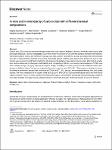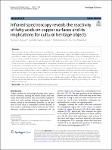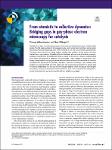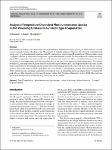Search
Author
- Osman, Ahmed I. (5)
- Daqing, Ma (3)
- Jorgensen, Ed (3)
- Li, Yan (3)
- next >
Subject
- kinh tế (26)
- Economics (12)
- programming (10)
- XRD (10)
- next >
Date issued
- 2020 - 2025 (2129)
- 2010 - 2019 (129)
- 2000 - 2009 (9)
- 1999 - 1999 (1)
Has File(s)
Search Results
Carbon dots (CDs) are easy-obtained nanoparticles with wide range of biological activity; however, their toxicity after prolonged exposure is poorly investigated. So, in vitro and in vivo toxicity of CDs with the surfaces enriched with hydroxylated hydrocarbon chains and methylene groups (CD_GE), carboxyl and phenol groups accompanied with nitrogen (CD_3011), trifluoromethyl (CDF19) or toluidine and aniline groups (CDN19) were aimed to be discovered. CDs’ in vitro toxicity was assessed on A549 cells (real-time cell analysis of impedance, fluorescence microscopy) after 24 h of incubation, and we observed no changes in cell viability and morphology. CDs’ in vivo toxicity was assessed on C57Bl6 mice after multiple dosages (5 mg/kg subcutaneously) for 14 days. |
The global increase of cutaneous wounds imposes huge health and financial burdens on patients and society. Despite improved wound healing outcomes, conventional wound dressings are far from ideal, owing to the complex healing process. Smart wound dressings, which are sensitive to or interact with changes in wound condition or environment, have been proposed as appealing therapeutic platforms to effectively facilitate wound healing. In this review, the wound healing processes and features of existing biomaterials are firstly introduced, followed by summarizing the mechanisms of smart responsive materials. Afterwards, recent advances and designs in smart and versatile materials of extensive applications for cutaneous wound healing were submarined. |
The reactivities of various fatty monoacids and diacids on copper metal-containing surfaces were investigated through reflection–absorption infrared spectroscopy. The formation of copper carboxylates is detected on pure copper surfaces, while copper and zinc carboxylates are simultaneously formed on brass surfaces. Following the decrease of acid carbonyl and the formation of carboxylate infrared bands, it is shown that fatty monoacids C8 and C10 react with clean/polished copper and its zinc alloy within 2–4 h, while those with chains > C12 react within days. At the end of the processes, only the corresponding metal carboxylates are detected in all cases. An explanation for the above is offered on a molecular mobility and acidity basis, where the lower monoacids (liquids in room temp... |
The purpose of this article is to consider the philosophy, form and function underpinning erasure poetry. Erasure is a creative practice involving redaction or the striking through of certain words, phrases, or paragraphs in found documents and materials. The poetic form is comprised of what is left behind. The form has grown in popularity in recent years due to the advent of social media and the fact that erasure poems’ pictorial format is easily shared online. This article suggests that the poststructuralist philosophy underpinning the form is also key to its traction insofar as it enables poets to expose the fallacy of justice communicated by official documents such as court transcripts and government reports. In examining traditional conceptions of the page as interface and the ... |
Uncrewed and autonomous marine vessels (UMVs) challenge the underlying paradigm of maritime laws and regulations. Yet UMVs are considered essential for safer, more efficient, and more effective maritime futures. There is a fundamental challenge facing industry and regulators about how to develop and support the nascent UMV industry while maintaining the safety and risk management principles and processes in legacy laws and regulations predicated on the conventional crewed vessel. This paper, drawing upon case studies of developer and operator experiences with Australia’s maritime safety framework, argues for an “intent-based”, flexible, and collaborative approach based on developers’ and operators’ experiences. The case studies show that ad hoc and bespoke regulatory pathways, utili... |
Trade treaties and legal agreements generally left Indigenous peoples and colonized communities out of negotiations that directly impacted them. Using Critical Discourse Analysis, informed by decolonial thinking and Nishnaabeg epistemology, this research study analyzed the language of five public documents, published by the World Intellectual Property Organization (WIPO) and the World Trade Organization (WTO), surrounding the protection of Traditional Knowledge (TK) through the sui generis legal figure and its connection to the development of digitization TK. As TK is largely uncommodifiable, the ability to identify and protect TK through Intellectual Property Rights within the WIPO and the WTO is encumbered. The research analyzed and explored how language and knowledge shape policy... |
Catalysis is a highly complex phenomenon involving fundamental processes on multiple length scales. The full-scale complexity of catalysis is only poorly understood, and how atomic-scale processes influence long-range order in the materials is not well documented experimentally. The result is that we still, to a large degree, develop new catalysts on the basis of iterative trial-and-error approaches. Elucidating the link between atomic-scale structural dynamics, feedback mechanisms, and collective behavior could be the key to a deeper understanding and further optimization of catalysts and processes. From imaging of quasi-static low-energy configurations through gas-phase-induced state switching to observation of complex nonequilibrium dynamics and oscillatory behavior, electron mic... |
The kinetics of the thermal oxidation of white metal and Cu2S have been studied by thermogravimetric analysis (TG), which was carried out under atmospheric oxidative conditions (O2 100%) with heating rates of 5, 10, 15 and 20 °C min−1. Each experiment was performed three times, the indicated values being the average of the three experiments. The experimental data were evaluated using isoconversional models based on the Arrhenius equation. The models are constructed using first-order mechanisms in the reactions and therefore, since most of them present adequate regression coefficients, it can be verified that order 1 is the most predominant order among the reactions found. In addition, the Kissinger–Akahira–Sunose model, which has the highest regression coefficient, is considered to ... |
Blast furnace ironmaking produces a reducing and carburizing atmosphere in the blast furnace which may lead to metal dusting. However, there is limited research on metal dusting under this particular atmosphere. This paper investigated metal dusting behaviors of ferritic Fe-(10, 20, 25)Cr and austenitic Fe-20Cr-(20, 33)Ni, Fe-25Cr-20Ni (wt.%) alloys at 550 and 650 °C in an Ar-33CO-7H2-7CO2-2H2O (vol.%) gas simulating a blast furnace operating condition. A relatively short reaction time, up to 100 h, was used to evaluate the initial stage of metal dusting of these alloys in the blast furnace gas condition. Severe metal dusting and coke deposition were observed at 550 °C, while no significant dusting but internal oxidation and carburization were observed at 650 °C. |
Photoluminescence (PL) is one of the commonly used methods to determine the energy gap (Eg
) of semiconductors. In order to use it correctly, however, the shape of the PL peak must be properly analyzed; otherwise, the value of Eg
is burdened with a large error. Eg
is often mistakenly attributed to the PL peak position, which in type-II superlattices (T2SLs) exhibits typical “S-shaped” behavior as a function of temperature, significantly different from the Varshni model used to define the energy gap of III-V compounds. The position peak of the PL relative to the real Eg
in T2SLs is red-shifted because of the carrier localization at low temperatures and blue-shifted because of the free carrier emission at high temperatures. To correctly determine Eg
, the shape of the PL peak ... |










